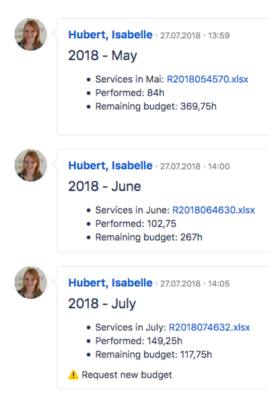
How do you explain functions of difficult-to-explain solutions to people who have never worked with them? By making fully confident users speak. So we just asked our colleague Isabelle what she likes about Dairy in Confluence.
Isabelle about her Diary in Confluence
First of all in advance: YES, I am employed at Scandio and I know and like the developers of our atlassian app “Diary” personally, but nevertheless I offered to write a blog entry about it. Simply because I am a fan of the functions!

A Diary in Confluence?
A detailed description of the needed solution Diary and its functions can be found here
In short: On a Confluence page you can create a diary that looks like a chat. However, this is used like a logbook. All the design options of a normal Confluence page are available without having to edit the entire page. The style can be adjusted very flexibly and through previously created templates, it becomes very easy to write more complex or repetitive entries regularly.
Where do I use Diary?
- Every week, two colleagues and I take information from an external source and process it. So that everyone knows which information has already been processed, we write it into a diary entry. This way, everyone knows the current status without having to edit the entire page every time for this little piece of information.
- Together with a colleague I organize Atlassian trainings for a client. On the corresponding Confluence page we have a table to track the status of each training. Every further communication, e.g. changes, discussions with the customer and suggestions are recorded in the diary.
- I always write invoices for our customers at the end of the month. Many customers have different ToDo’s and things to consider and in addition the invoice is checked by two persons. To keep an overview I created a template in which every customer is registered. For each invoice there is a checklist of the different tasks who has to check the invoice. This has become a rather large table with many ToDo boxes by now, but nothing else arranges it so clearly for me. Every month I create a new entry and my colleagues and I only have to check which invoice has already been reviewed and I can see at a glance what else there is to do. Afterwards I can easily adapt the template for the next month.
- I regularly inform my colleagues how much work has been done in a project, how much budget is still available and attach an overview of the services as an excel table. Instead of editing the whole page or creating a subpage every time, I can put it into a diary entry. Everyone can read clearly how the project has developed.


How can everyone use Diary for themselves?
Especially to keep track of repetitive tasks, Diary is unbeatable. Surely every Confluence user will find one of these things he or she does:
- regular meetings
- regular tasks that always require similar processing
- status updates
- changes to a project/page
- tracking progress
Everyone knows these Confluence pages, which have a lot of subpages with very little content. Nevertheless, they are copied again and again in order to change the content minimally. With Diary everything remains clearly arranged on one page.
What’s so great about Diary?
Once you have found a task where you can use Diary, you won’t want to give it up anymore!
- The diary macro is inserted very quickly and there are a few simple but practical design options.
- The templates are very easy to create and very practical to use.
- Anyone can edit or delete an entry.
- All information is in one central location.
Why should you try Diary?
We know that Diary is an app that needs a little more explanation. But it is actually so easy to use! So, go on and try it for free!




.png)






